Tactical analysis of Celta Vigo’s innovative tactics vs Real Betis
- nigel133
- May 25, 2021
- 7 min read
When FC Barcelona’s title dreams ended on 16 May, very little was made of the team that ended the Blaugrana‘s title chase. Eduardo Coudet’s Celta Vigo won at Camp Nou thanks to two goals by Santi Mina and recorded their fifth successive win that night. Ever since Coudet was appointed, Celta have impressed and ultimately ended the season in eighth place. In this tactical analysis, I take a look at their interesting tactics, which include a shape I would largely describe as a 4-1-3-2 that acts in unusual manners. The examples are taken from their final game of the season at home to Real Betis, where Celta stormed into a 2-0 lead, but eventually lost 3-2 after conceding three set-pieces to end their impressive run.
Starting eleven
Coudet’s Celta lined up in a 4-1-3-2 where Ivan Villar was in goal, Kevin Vázquez started at right-back with Néstor Araujo and Carlos Dominguez as centre-backs and Aarón Caricol at left-back. Fran Beltrán started as the lone defensive midfielder behind a trio of Brais Mendez, Denis Suárez and Nolito. Club legend Iago Aspas started up front alongside Santi Mina. The team had an average age of 23.6 despite the inclusion of the experienced heads Aspas and Nolito who are both well into their 30s, highlighting the exciting nature of this team.
Pressing schemes
Firstly, let’s look at the way Celta pressed. The unusual bit with their midfield setup was that the two wide midfielders actually acted like wide midfielders. Normally when teams use diamond-like midfield setups, the widest midfielders are usually acting as normal central midfielders. Celta, however, had theirs in more traditional wide positions, resembling positions wide midfielders would pick up in a classic 4-4-2.
We can see this in the image below as the left-sided midfielder Nolito is more orientated to the wing area than the half-space. Mendez, on the right, has tucked in slightly with the ball on the left half of the pitch from Celta’s perspective. The front-two, as seen below, started the press alongside each other in quite narrow positions.
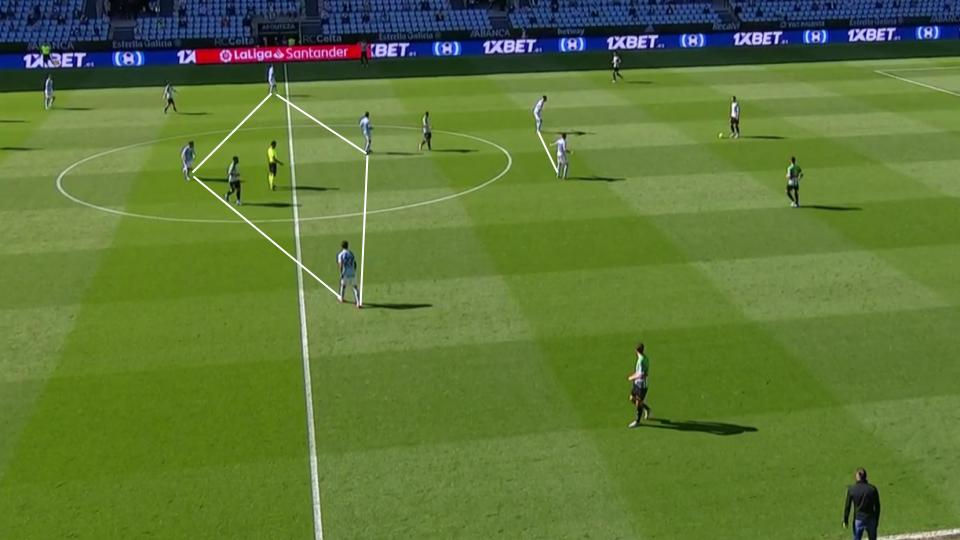
Celta’s 4-1-3-2/4-Diamond-2 setup out of possession.
When Celta pressed high, they used clear man-orientations. We can see this in the image below as the two strikers are orientated towards either Betis centre-back, the number ten Suárez moves towards the left to stop passes into a midfielder while the defensive midfielder Beltrán steps up high to mark the other Betis midfielder. Again, Nolito and Mendez are in wide positions ready to press Betis’ full-backs.
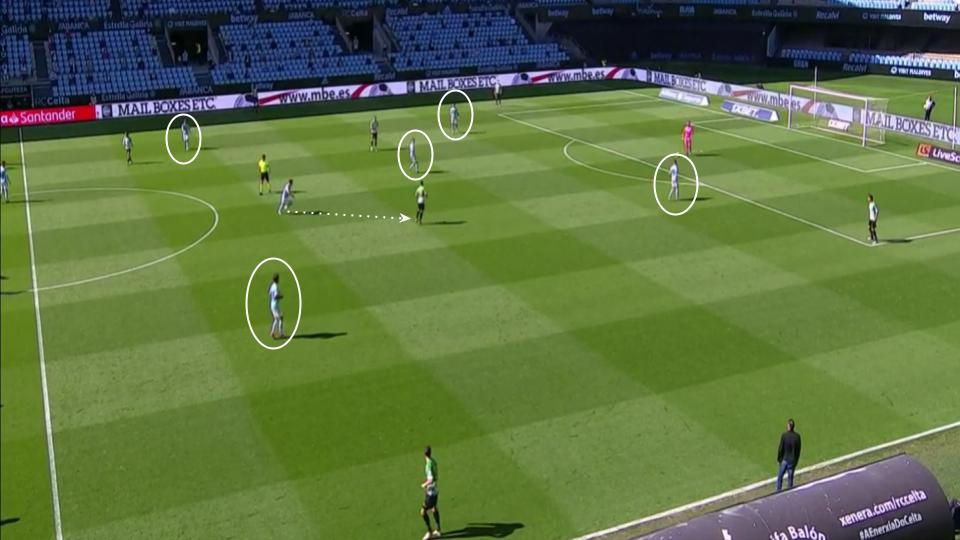
Celta’s high press – clear man-orientations with Beltrán stepping out to mark an opponent.
The man-orientations are even clearer in the below image with Beltrán and Suárez (sky blue arrows) have moved really high while the centre-backs (yellow arrows) also step out of their starting positions to mark the dropping Betis players. This approach of ‘filling’ central positions by pushing players up to press is something we have previously seen Vincenzo Italiano’s Spezia perform to great success.
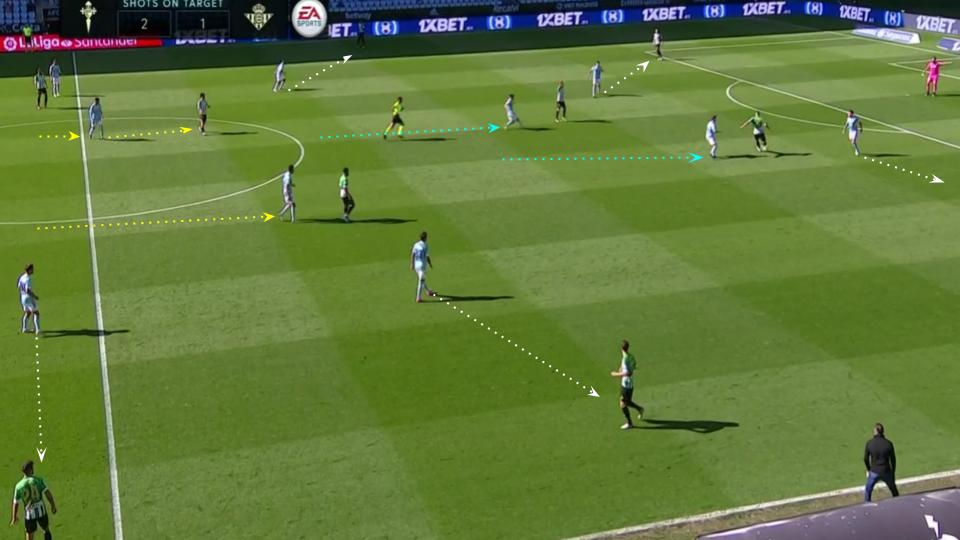
Every Celta player is ready to mark/press an opponent if needed. Look at the centre-backs leaving the defensive line, for instance.
As mentioned above, Celta’s wide midfielders were more concerned with the wide spaces than the half-spaces, so Celta needed to deal with those as well. In the image below, we can see how they did this. Again, we can note their 4-1-3-2 structure with Beltrán (circled) behind a line of the other three midfielders. Nolito’s focus on the Betis right-back opens up the half-space for the winger to receive in, but the Celta left-back Caricol then steps in to press the receiving player from behind.
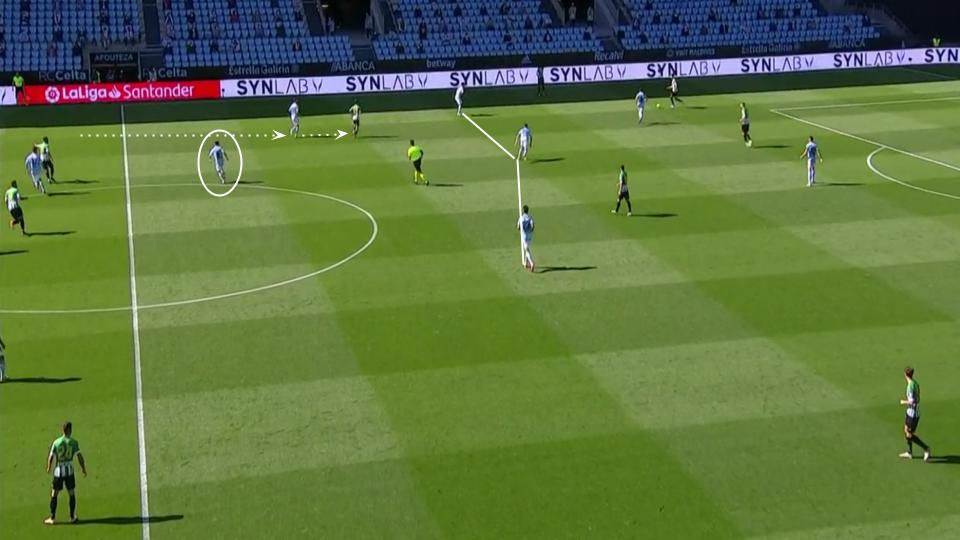
Caricol stepping inside to defend the half-space Nolito has vacated.
This was a recurring aspect of Celta’s pressing, the left-back defending the half-space and Nolito defending wide. Since Betis lacked a natural wide threat high on the right, this was a clever move which led to a few really good counter-attacking situations. We can see this again below as Nolito’s (circled) positioning opens up a central passing lane which Caricol then closes. The main benefit of this setup when winning the ball back was that Celta immediately had their two strikers, Suárez and Nolito ahead of the ball to spring counter-attacks.
On the opposite side, Mendez was also orientated towards the wide space, but still performed a more narrow role than Nolito. In the image below, we can see how Celta overloaded the space around the ball with the ball-near striker, Beltrán and Suárez supporting Mendez and Vázquez. Nolito, however, is not interested in coming inside, instead remaining far away which obviously opens up a lot of space centrally. As we know, though, Caricol would then defend that space if the ball was played in there.
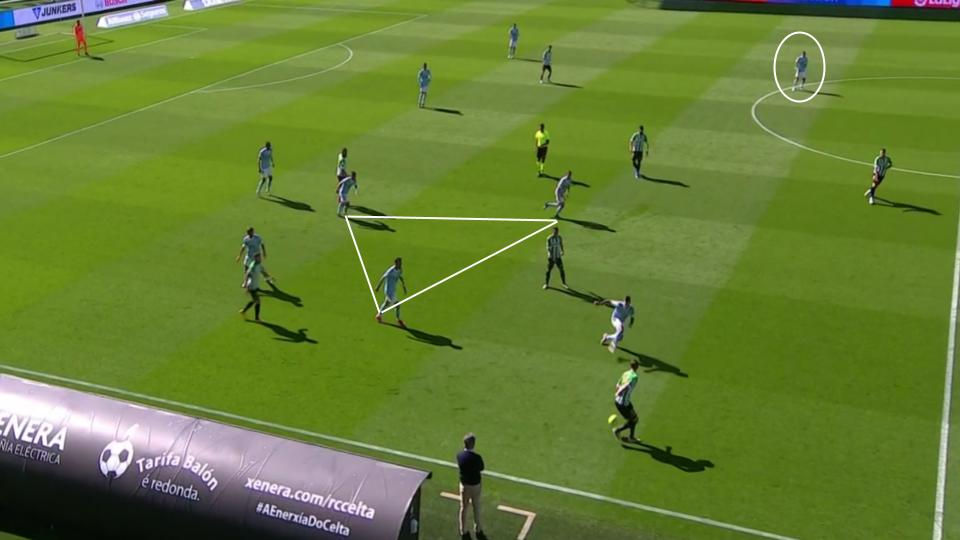
Nolito (circled) not involved in overloading the wide area.
If Betis managed to switch the ball quickly, the defensive midfielder Beltrán and the attacking midfielder Suárez would split to form a flat midfield four, creating a 4-4-2 structure in the process.
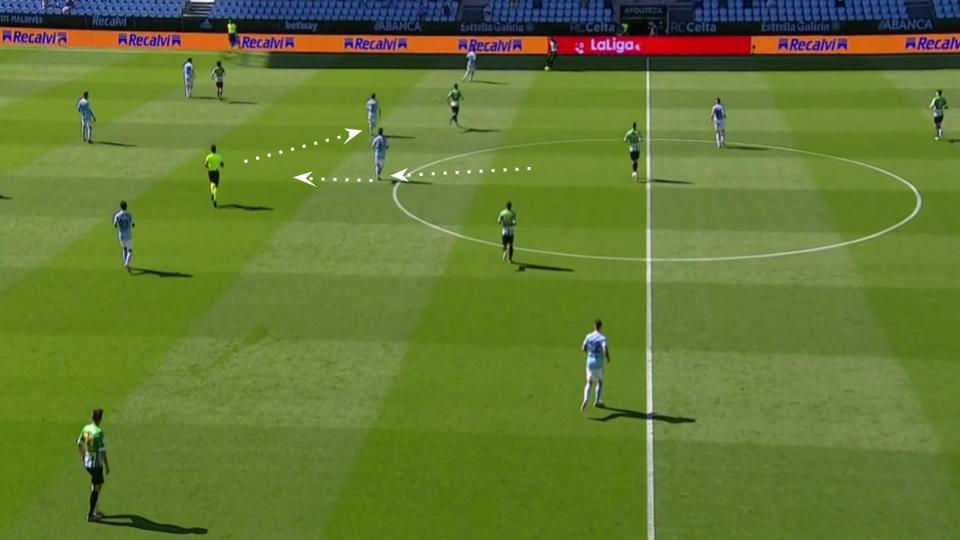
Beltrán and Suárez splitting to create a flat midfield four.
We can see this structure below with the Betis right-back (circled) in possession. Here, Betis had a wide threat so Caricol was wide, meaning Beltrán had to defend the wide space with Suárez dropping to defend the central space Beltrán’s supporting movement had vacated.
Generally, Celta’s pressing was very good and they dominated the game despite losing in the end after conceding three set-piece goals in twenty minutes.
The ‘Y’ midfield
If Celta’s setup was intriguing out of possession, the tactical approach to their attacking positional structure was even more interesting. They looked to build from the back with the two centre-backs (white) splitting wide and Beltrán (yellow) looking to receive behind Betis’ first pressing line or by dropping into the space between the centre-backs. The latter usually occurred higher up the pitch. As you would expect, the two full-backs pushed high to create vertical passing options.
All this can be seen below, but what was innovative was the attacking midfielder Suárez also dropping into positions in front of Betis’ midfield. Normally, we see the number ten in systems like this one play between the lines of the opponent’s defence and midfield but Suárez dropped even deeper.

Centre-backs splitting wide, Beltrán dropping in, full-backs high and Suárez also dropping.
Nolito and Mendez would come inside and leave the wide spaces for the full-backs (circled) to attack, creating the Y-shaped midfield setup we can see below. I can’t remember the last time I saw a team do this so this is definitely an innovative setup from Coudet.
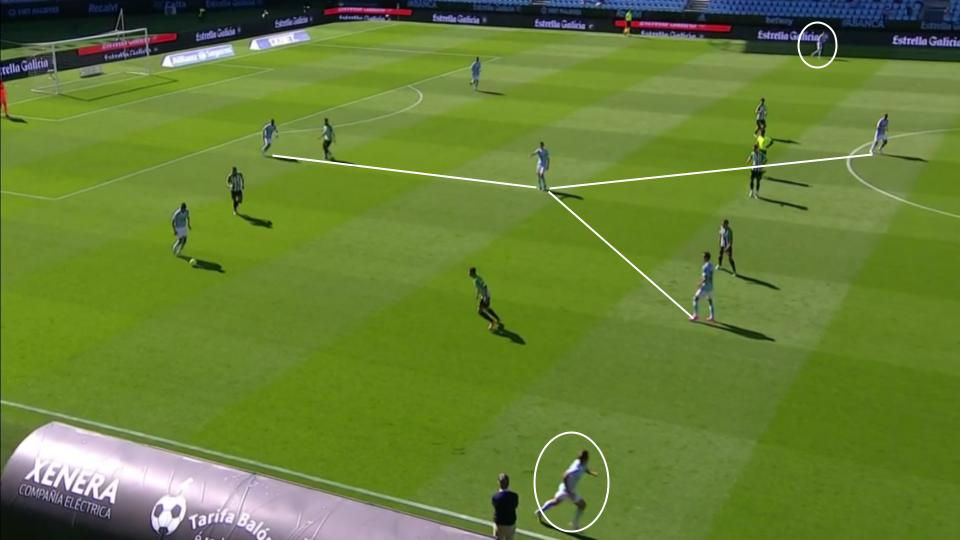
Celta’s Y-shaped midfield with Beltrán at the base, Suárez in the middle and then Mendez and Nolito as the two branches higher up.
These movements created the positional structure highlighted below, with Celta structured in a way that is most accurately described as 2-1-3-2-2 but in less flashy language as 4-Y-2. It’s fresh, it’s interesting and it worked, as Celta enjoyed 65% possession on the day.
What did this give them, then? Well, when the centre-backs looked for progressive passes, Celta could create a diamond structure with the centre-back at the base, the full-back wide, the wide midfielder at the tip and Suárez on the right. Additionally, Beltrán would support the ball-carrier, either inside or behind the centre-back. This created problems for Betis’ two central midfielders as Celta overloaded the midfield area. In the image below, Nolito and Suárez provide passing options for Dominguez either side of the Betis player.
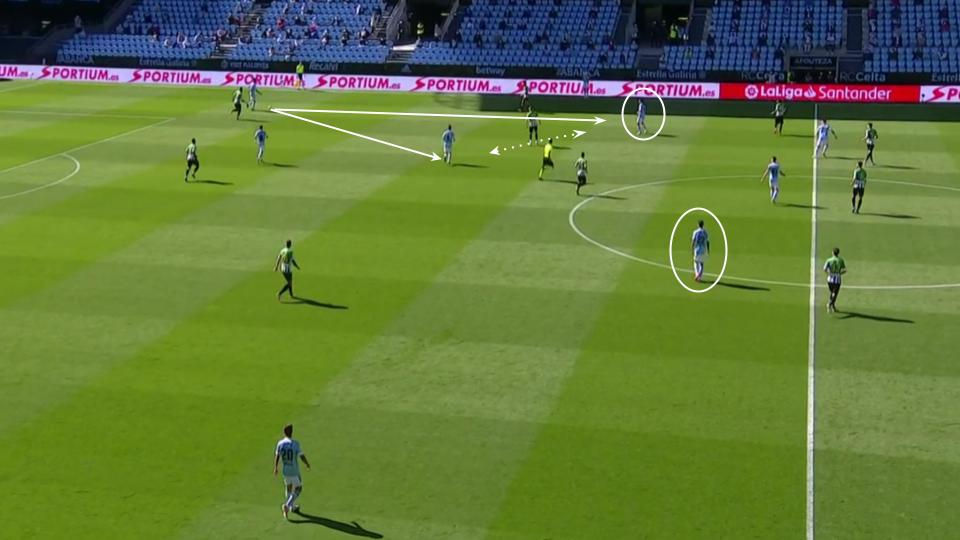
Dominguez on the ball with two progressive central options in Nolito and Suárez. Note Mendez positioning (also circled) on the right as Vázquez pushes forward from right-back.
Higher up the pitch, since Suárez dropped out of the space between the lines of defence and midfield, he could often pick the ball up in plenty of space as the Betis double pivot were pinned by the narrow positioning of the wide midfielders. In this way, Suárez had multiple progressive passing options centrally as you can see below. Naturally, all the central options forced Betis to narrow their defending, but the high full-backs, as demonstrated below, provided an additional avenue for ball progression.

Suárez facing forward with plenty of options.
As mentioned, this Y-shaped midfield is not common but it had some notable advantages. However, there were some problems too as it could be difficult for Beltrán and Suárez to shift across in time to support if Celta switched the play quickly. In those situations, only the wide midfielders provided options for the full-back in possession, which made it more difficult to then progress the ball, but sometimes Mendez, in particular, dropped deeper and Aspas dropped off the front to fill his position.
Rotations and variations
Even if Celta mostly used the Y, they weren’t static. For instance, sometimes Suárez, as seen below, would drop alongside Beltrán (yellow) to create a box in midfield. His movement often attracted one of Betis’ midfielders to follow him, which then opened space for the two situational ‘tens’ (white) who outnumbered the remaining midfielder 2v1. Equally, a full-back (as seen below) could step into midfield, which then opened up the option of a long ball into the channel for a striker to isolate a defender 1v1. In essence, Celta created problems for Betis.
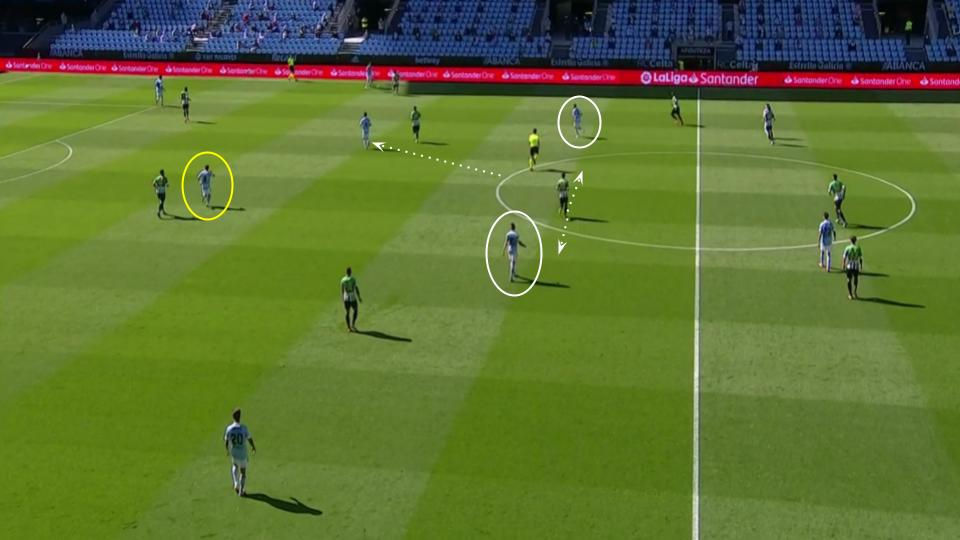
Celta’s situational box midfield.
Another rotation Celta used was for Aspas to drop off the front into the ten space Suárez dropping movement had vacated. The image below highlights this movement.

Aspas dropping off the front.
As you’d expect from a team looking to pass their way through teams, third man combinations were a key part of Celta’s attacking play. Their opening goal was a case in point. Here, Araujo stepped out with the ball and played it into the dropping Aspas. At the same time, Vázquez attacked the space behind Betis’ defence.
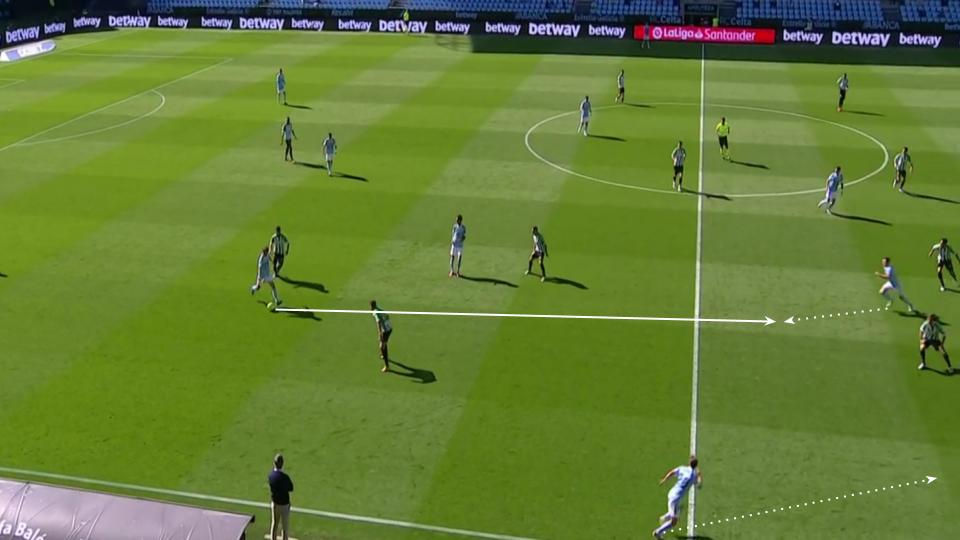
Scene 1: Araujo to Aspas, Vázquez in behind, confusion as to which Betis defender picks up Aspas.
Aspas then immediately released Vázquez in the channel. Betis’ left-back ended up stepping out to Aspas, leaving the ball-near centre-back to deal with Vázquez and isolating Mina with the other (circled).
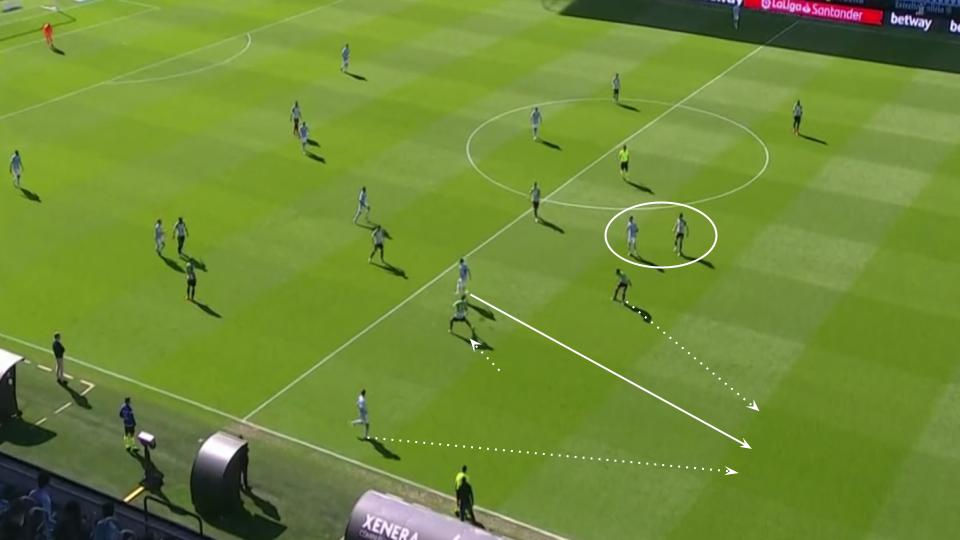
Scene 2: Aspas to Vázquez.
With that massive gap between the centre-backs that was opened up when one was forced wide, Mina beat the defender into it and was fouled which resulted in a penalty.
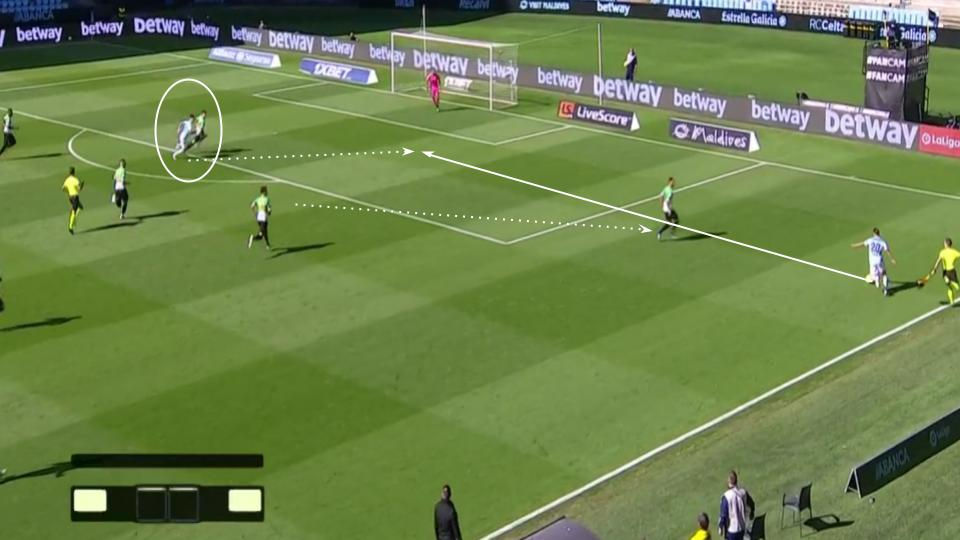
Scene 3: Mina was first to the cross and fouled.
Betis could, of course, have defended this better but it highlighted how effective Celta’s possession play was at times.
Conclusion
In conclusion, Eduardo Coudet’s Celta Vigo have looked really interesting this season and it was the same against Real Betis. They will be disappointed to have lost a game they dominated, but finishing eighth and ending the season as well as they did promises well going into next season. This tactical analysis of their tactics has sown that they play an unusual style of football and it will be interesting to see how their Y-shaped midfield evolves next season. With a full pre-season and some smart additions, Celta will certainly look to challenge for the Europa League places next year.
Follow David on Twitter here and follow us at @RunTheShowBlog as well!



Comments